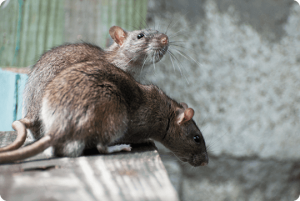Rat-free Life with Professional Rat Control in Melbourne
- Careful inspection of the property
- Using top of the line products
- Qualified and experienced pest controllers
- Friendly customer support
Rodent Control in Melbourne - The Easiest Way to Get Rid of Rats
Rats can cause great damage to your house, contaminating food and generating unpleasant odours. These rodents pose a risk to human health because they can carry diseases such as leptospirosis, salmonella and typhus fever. Besides, rats easily chew through different materials in your house. They can destroy plastic, leather, cables and even metal.
Nobody is immune to rodent infestations, but when they happen, they are here for a reason. The key factors that attract rats are poor sanitation, warm hiding spots and all kinds of food left in the open. In fact, these pests will feed on every piece of food they come across in your house. Once rats find a comfortable home, they hardly ever leave it.
If you’ve heard scurrying sounds, found suspicious holes or seen thin droppings in your house, then you probably deal with rats. You need to act fast and prepare for a potential infestation. But don’t worry - you can always rely on the pest exterminators in Melbourne and let the professionals deal with your problem for good.
Signs of a rat infestation
Rodents adjust to living in human environments and are generally more active at night. If you’re still uncertain whether you have rats in your home, look for the following signs of rodent activity:
- Droppings - rat droppings are dangerous to humans and pets as they contaminate food and transmit bacteria and diseases. Brown rat’s droppings are rectangular and have blunt ends, while the black rat’s droppings are spindle-shaped and smaller in size.
- Sounds - you might hear scratching and scurrying sounds that come from the ceiling, the attic or even the walls. No matter where the rodents are located, their annoying sounds will keep you up at night.
- Tracks - rats usually leave small distinctive marks forming patterns in mud, dirt and dust. The pesky rodents often leave tail drag marks between their foot tracks as their tails are relatively long.
- Urine stains and odours - the unpleasant rat urine odour can be easily sensed if a room isn’t properly ventilated. You might detect stale smell coming from the hiding spots of the rodents or even see stains around your house.
- Partially consumed food - the main factor that attracts rats in your home is food. If you notice gnaw marks on food packaging, partially consumed food and suspicious crumb tracks, then you probably deal with rodents.
- Nests - rats are very resourceful - they built nests from twigs, cardboard boxes, fabric and other easy-to-shred materials. You might find their nests between walls, under porches or inside debris piles in your yard.
- Dead or live rodents - the main evidence of infestation is noticing a rat, no matter dead or alive. Unfortunately, If you spot one, then others are nearby. In this case you should act quickly in order to prevent an even larger infestation.
Inspection
The rat removal procedure begins with a thorough inspection of your property in order to assess the full extent of the infestation. Once the exterminators know what they are facing, the proper steps to eliminate the issue will be taken (check the Rat Control section).Depending on the infestation our technician can proceed with sealing or blocking small entry points (up to 3 cm diameter) with expanding foam and other sealants.
Rat Control
The rat exterminators in Melbourne have all the means necessary to handle the infestation. After the inspection, they will proceed with baiting - up to 4 stations with rodenticides.They can:
- Deploy traps and baits - the baits are rodenticides in nature, so their effectiveness against the furry pests has been proven more than once.
- Place mechanical traps - these traps follow a more direct approach to the problem.
Both solutions are effective against rats. Please, note that mechanical traps belong to the company, so the pest technicians will collect them at the end of the treatment period.
Results from the treatment can be seen within 3 weeks as the rodents have a fear of new objects or changes in their familiar environment. It takes a few days for the rats to start to feed on the bait.
Secondary Visit
If you request a follow-up visit within a 60-day period after the first service, the rat control experts will return to determine the effects of the treatment. They can remove dead rat carcasses, reload the traps, and see if anything else will be required. We aim at providing complete satisfaction to all our clients, so don’t hesitate to request a second visit. It’s always worth it.Professional Advice
The rat exterminators will provide you with some professional advice on how to avoid future rat infestations. They will explain what rats look for in your home and what to do in order to reduce the chances of another infestation.if you have other pest problems, don’t hesitate to contact us. We offer other services, such as mice extermination in Melbourne.
Know Your Enemy
Physical Appearance - rats have big heads with huge teeth. Their bodies can easily reach 28-30 centimetres, with tails reaching 20-22 centimetres. Rat bodies are prolonged, covered with small, rough hairs. Their feet, ears, and tails are naked in order to ensure proper navigation.
Behaviour - Rats usually use burrows or holes as their improvised homes. If they can’t find a suitable hole, they’re perfectly capable of creating one, themselves.
Procreation - Rats have a pregnancy period of 21-23 days and give birth to around 10 babies on average. A female rat can become pregnant immediately after birth, but such a pregnancy continues to about a month. Rats begin to procreate around 6 weeks of age.
Types of Rats
You probably want to know what type of rat you’re dealing with. There are three best-known species:
- Black rat - black rats (also known as Roof rats) are rodents with large eyes and ears, a pointed nose and a scaly long tail. Their body is thin and between 16-25 cm long. They are good climbers and they usually build nests in the upper areas of the house. Learn more about black rats in the Pest Library.
- Brown rat - brown rats (or Norway rats) have a blunt nose, small ears and a thick body. Their tail is scaly and shorter than the body. These rodents are up to 40 cm long and usually prefer ground living and burrowing. Find more information about brown rats.
- Bush rat - bush rats are native rat species with grey-brown fur, rounded ears and a short tail. These rodents are not pests and can be rarely found in urban areas. Bush rats usually live in forests, woodlands and heath and prefer to line their nests with grass.
How to Prevent a Rat Infestation
After you’ve successfully dealt with the rat problem, you would probably want to prevent a future infestation. Take a look at our professional tips and remain safe from rats:
- Keep your home clean - you should always keep your house tidy and free of clutter, as pests enjoy living in it. We advise you to clean your property thoroughly at least once a week so you don’t give the pests a comfortable place to live.
- Seal holes and cracks - rats usually live inside tiny cracks and crevices. Fill in every visible hole around utility cables or pipework and make sure that your windows are properly screened. You can do it by using caulk, steel wool or a combination of both.
- Protect your food - the pesky rodents have a sensitive sense of smell. Don’t leave any food in the open and always keep it in airtight containers. This way rats won’t be able to sense it and won’t be attracted.
- Secure your rubbish bin - put your garbage bags in secure metal cans with fitted lids so rats won’t have access to your waste. Remember that the rodents are resourceful and will feed on your rubbish if it’s an easy target for them.
- Get a cat - if you want to prevent rat problems in the future, consider getting a cat. Cats are natural predators and will gladly keep the pesky rodents away from your home.
Frequently Asked Questions
How can I keep rats away from the garden?
Rats cannot stand the scent of mint, so make sure you plant some in your garden. It will act as a natural deterrent for rodents and other types of pests. Another thing you can do is place motion-activated sprinklers. When something moves in your garden, the sprinklers will chase it away. This works for possums, as well.
Is it possible to keep rats away without using poison?
Yes, it’s possible. There are several methods you can try, though none of them gives you any guarantees. Seal all holes and cracks you can find. This should prevent them from getting in. Also, rats have a rather keen sense of smell, so strong scents like peppermint can keep them away. Place natural rat deterrents where you think they might be entering your home. Another option you can use is an ultrasonic emitter, though their effectiveness has been widely debated.
Do rats have the ability to climb vertical surfaces?
Yes. Rats are extremely capable climbers and have no problem climbing up vertical surfaces. That’s how they usually end up in your attic and why you often don’t realise you have an infestation right away.
How long does it take for the poison to work?
This is relative. It depends on both the size of the rodent and the quantity of the poison it has consumed. Usually, the entire treatment takes two to three weeks until enough poison has accumulated in the rodents’ bodies to kill them. At the same time, your pets will remain completely safe.


